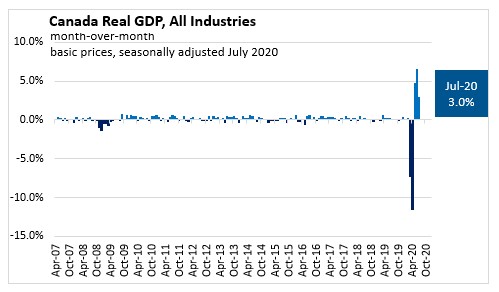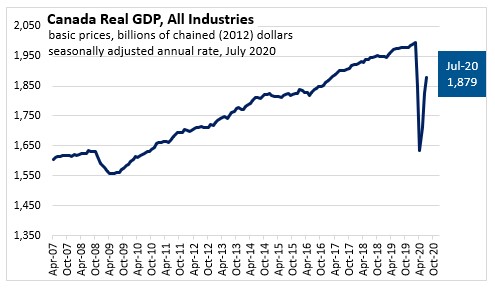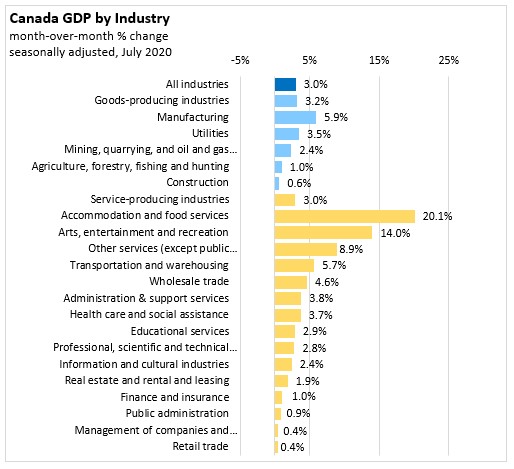The Economics and Statistics Division maintains archives of previous publications for accountability purposes, but makes no updates to keep these documents current with the latest data revisions from Statistics Canada. As a result, information in older documents may not be accurate. Please exercise caution when referring to older documents. For the latest information and historical data, please contact the individual listed to the right.
<--- Return to Archive
For additional information relating to this article, please contact:
September 30, 2020CANADA GDP BY INDUSTRY, JULY 2020 & AUGUST 2020 [PRELIMINARY] Statistics Canada’s preliminary estimate for real Gross Domestic Product (GDP) points to an approximate 1 per cent increase in economic activity in August 2020. While economic recovery continues, the pace of growth will be moderate compared to what was observed in May to July. This flash estimate indicates that most sectors continue their growth trajectory in August with the exceptions of retail trade and public administration. These preliminary estimates will be revised with the release of the official GDP data for August on October 30, 2020.
Real Gross Domestic Product (GDP) in Canada increased 3.0 per cent in July. This was the third consecutive monthly increase and followed a 6.5 per cent gain recorded in June. The continued increase in economic activity offset the sharp declines experienced in March and April. However, overall economic activity was still about 6 per cent below the pre-COVID levels seen in February.
Compared to July 2019, the Canadian economy declined 5.0 per cent with an annualized value of $1,879 billion (chained 2012 dollars) in July2020.


Goods-Producing Industries
Output for goods-producing sector increased 3.2 per cent with all subsectors registering monthly gains.
The manufacturing sector output increased 5.9 per cent in July, following a 15.1 per cent gain registered in June. While many factories continued to ramp up their production according to the Monthly Survey of Manufacturing, overall activity remains 6.0 per cent below February’s level.
Durable manufacturing increased 5.7 per cent in July posting the third consecutive monthly gain. This gain was mostly supported by a 16.6 per cent increase in transportation equipment manufacturing. Motor vehicle (+10.5%) and motor vehicle parts manufacturing (+38.6%) continued scaling up production, following a pandemic-induced shutdown, to meet increased consumer demand.
Non-durable manufacturing output was up 6.2 per cent in July. Plastic and rubber products (+17.9%) and chemical manufacturing (+6.0%) contributed most to the growth, along with a 6.3 per cent increase in petroleum and coal product manufacturing.
Services-Producing Industries
Output of services-producing sector increased 3.0 per cent in July 2020.
Following sharp declines in March and April, accommodation and food services output increased 20.1 per cent in July posting the third consecutive double-digit monthly gain.
Activity at food services and drinking places increased 17.6 per cent as establishments continued to reopen and customers got used to new rules and restrictions. As reported by the Food Services and Drinking Places survey, activity grew at all types of restaurants as well as bars, pubs and some nightclubs as summer and patio-season progressed.
With many Canadians choosing to close-to-home vacations, output in accommodation services increased 27.6 per cent in July. Despite these strong gains, output across both accommodation and food services remained approximately 43 per cent and 29 per cent below their respective pre-pandemic February levels.
The transportation and warehousing sector rose 5.7 per cent, as all 10 subsectors were up. Leading the growth were support activities for transportation (+8.0%) and truck transportation (+3.8%).
Wholesale trade output increased 4.6 per cent in July, as all nine subsectors expanded. The main contributor to this growth was the 6.0 per cent gain recorded in machinery, equipment and supplies wholesaling subsector.
The professional services sector output increased 2.8 per cent in July, up for the third consecutive month. Except for declines in March and April, the sector has been continuously growing since November 2017.
After surpassing the pre-pandemic levels of activity in June, retail trade edged up 0.4 per cent in July as 7 of 12 subsectors were up. Leading the growth were clothing and clothing accessories stores (+11.2%), motor vehicle and parts dealers (+3.2%) and gasoline stations (+6.5%), while building material and garden equipment and supplies (-10.2%), sporting goods, hobby, book and music stores (-7.6%) and food and beverage stores (-1.2%) offset some of the growth.
Output in construction sector increased 0.6 per cent in July. This was supported by gains in residential (+2.4%) and repair (+2.5%) construction which more than offset lower non-residential construction (-3.0%) and engineering and other construction (-0.5%).

Source: Statistics Canada, Table 36-10-0434-01 Gross domestic product (GDP) at basic prices, by industry, monthly (x 1,000,000)
<--- Return to Archive